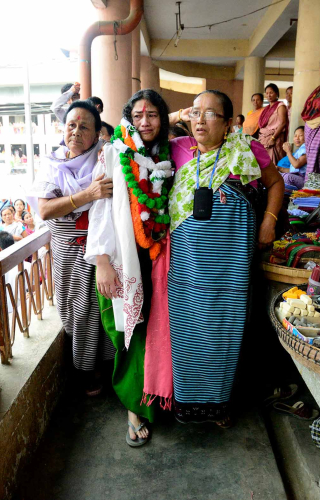In Manipur, Nupi Keithel is popularly known as Ima Market. The use of ima (mother) instead of women is significant and not without reason; it signifies that the women vendors here are all married, or had been at one point in their lives. It has been a while since I last visited Nupi Keithel, as it is closed due to the COVID-19 pandemic and is undergoing much-needed renovation in this time of low activity. Before the pandemic hit Manipur, I had visited the market several times, sometimes to buy things I needed for my home, and on other occasions to shoot the market premises and the ima vendors, with whom I enjoy interacting.
The Nupi Keithel complex is spread over three large buildings and a makeshift temporary market. Leimarel Shidabi Ima (Purana Bazar) is the largest and the oldest of the three structures. In all three buildings, only the ground floors are allocated to imas. The floor is divided into sections and loosely segregated according to the items sold. The vendors sit on raised concrete platforms. These platforms are multipurpose spaces, and serve not only as stalls but also for storage, and even for eating and sleeping. Nupi Keithel is a one-stop destination to avail every conceivable item needed in running a Meitei household. Purana Bazaar, housed in the main building of this market complex, has a small Meitei shrine at the southern entry. This shrine is the abode of Ima Keithel Leirembi and her male consort, Leiramba. Keithel Lairembi is a female deity associated with market, commerce, trade, stock and fortune. Adjoining this shrine, most vendors sell flowers and other ritual items used in the Hindu and Sanamahi religious traditions of Manipur. In the east-facing rows one will see stalls selling bamboo products, pure cotton threads, jewelleries and various types of fruits and flowers. Fermented dry fish is one of the most essential food items used in Manipuri cuisine, and it can also be found in this part of the building. On the northern end, vendors can be found selling various types of fresh fishes. However, these fishes are not caught by the women themselves or their families, but bought from wholesalers and sold at a profit in the market. Laxmi Bazar (Emoinu Ima Keithel) is located opposite of Purana Bazaar's southern entry across Bir Tikendrajit Road. It is the smallest of the three buildings, and household items such as bed covers, mosquito nets and bed sheets are sold here. Textile items like shawls, and other traditional clothes are also sold here. The stalls are lined with colourful shawls from the different indigenous communities of Manipur. Tailors can be seen busy at their sewing machines, making alterations to the various garments sold here. The stalls at New Market (Phouibee Ima Keithel) mainly sell handloom items, especially Meitei traditional clothes such as various phaneks (traditional Manipuri sarong), sarees and inaphi.
Although an economic space, Nupi Keithel holds a significant place in the socio-cultural landscape of the Meitei community. The centrality of Nupi Keithel at Imphal, the capital city, as well at the village level (Leikai Keithel), meant that the women could organise themselves and put up a united front in times of economic, political or social crisis. This also meant that women were not solely dependent on male family members in managing their personal finance. The relatively high mobility of women working outdoors and their dominant role in markets is a cultural factor Manipur shares with other North-Eastern states in India, and Southeast Asian countries. Agency of Meitei women should be understood in the context of how the Keithel evolved. Imperial Kangleipak (old name of Manipur) never maintained a standing army. Using a forced labour system called lallup, Meitei kings raised soldiers from common citizens. Through lallup, the king made it the duty of every male between 17 to 60 years of age to make himself available for military and civil service—without any remuneration—for ten days in every 40 days of work. As men of the family became unavailable for extended periods, the married womenfolk could no longer confine themselves to only domestic chores. They now had to step out of the threshold, and gather in such markets to barter, sell and buy commodities. This kind of informal markets were the first keithels, run solely by women.
Imperial Kangleipak was decimated when Burma annexed Manipur (1819), and the brutal aftermath of the Burmese occupation extended from 1819 to 1826. This invited the attention of the East India Company, who stepped in to fight the Burmese, and after the Burmese retreat in 1826, Manipur became a vassal of British India. British rule soon became oppressive after the defeat of Upper Burma in 1885, and Imphal saw yet another devastation during the Anglo-Manipuri war of 1891. Bir Tikendrajit Singh was hanged for his role in the uprising and Maharaja Kulachandra was deported to the penal colony at Andaman Islands. In 1904, the Assistant Superintendent of Police’s bungalow was burnt down, and in retaliation the lallup system was reinstated to rebuild the bungalow. Forced labour of their menfolk was opposed by Meitei women in what is known as the first Nupi Lan (Women’s War), in which more than 5,000 women took part. Although British agents succeeded in suppressing the uprising, which lasted for a week, they were compelled to cancel the lallup order. It is ironic that the Lallup system which resulted in the establishment of the keithels, ultimately became the reason behind the abolition of the same practice. A similar women-led uprising happened in 1936, the second Nupi Lan. This time Manipuri women collectively resisted the economic and administrative policies of the incompetent maharaja and the British political agent. Though lallup had been abolished by then, Manipur was facing a famine-like situation because the rice it grew was exported through Marwari businessmen who enjoyed the support of British agents. The second Nupi Lan lasted much longer and ended only with the outbreak of World War II. The two Nupi Lan may be regarded as the political awakening of Meitei women and their mobilisation through the keithel.
Post-Independence, from the 1970s until very recently, Manipuri society saw a renewed ruin of its male population due to alcoholism, drugs, decades-long insurgency and excesses committed under the Armed Forces Special Powers Act (AFSPA) of 1958 by the security agencies. It was inevitable that the women once again organised themselves to oppose the highhandedness of the state and as a reaction to social decay. This led to the rise of social movements like the vigilante Nasha Bandi, which campaigned against alcoholism and forced prohibition in the state. From this movement evolved Meira Paibi (Women torch bearers), started in 1977, in Kakching district; they spearheaded the anti-AFSPA movement and sought redress against human rights violations. The Meira Paibi movement has come to be known as the third Nupi Lan, in which market vendors played a key role.
Through such political movements, the keithels have proved to be a force to reckon with, but their effect has been felt more at the grassroots level. Though they have greatly empowered women, their influence has been restricted to that of a pressure group. They have been unable to directly participate in policy-making on the same level as their male counterparts. This is also true of their role in the economy, in which women mostly occupied the more disorganised economic sector while the larger economic institutions are managed by men and outsiders. This difference in power hierarchy has meant that our mothers have not been able to substantially improve their own life by expanding their business or play a bigger role in politics, but are confined to the support network of the keithel where they work. Thus the Nupi Keithel is not only a product of Manipuri history but also a microcosm of Manipuri society, gender politics and political autonomy.
















